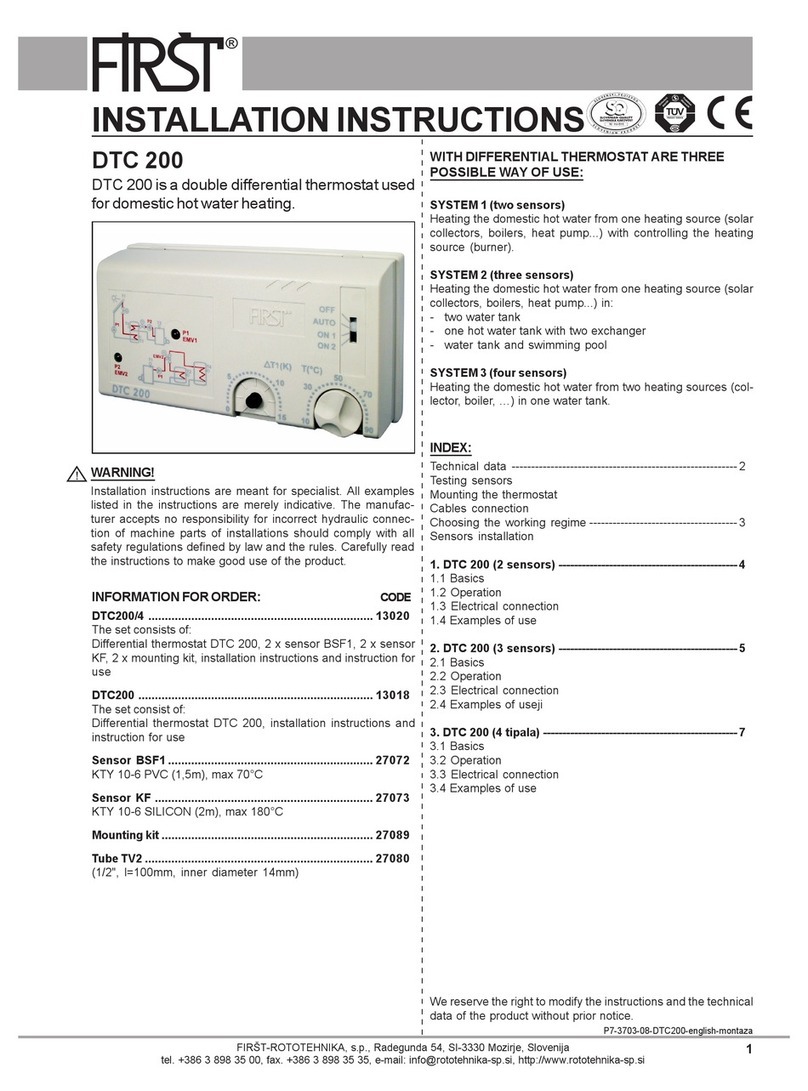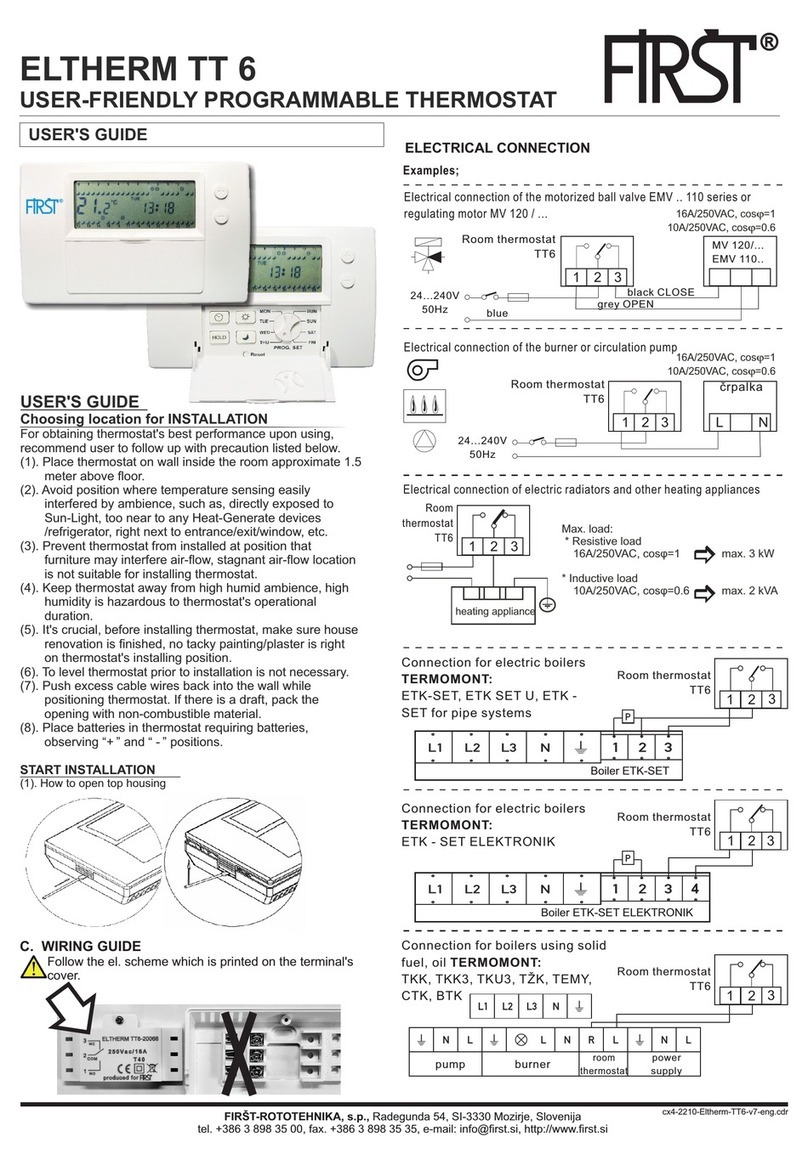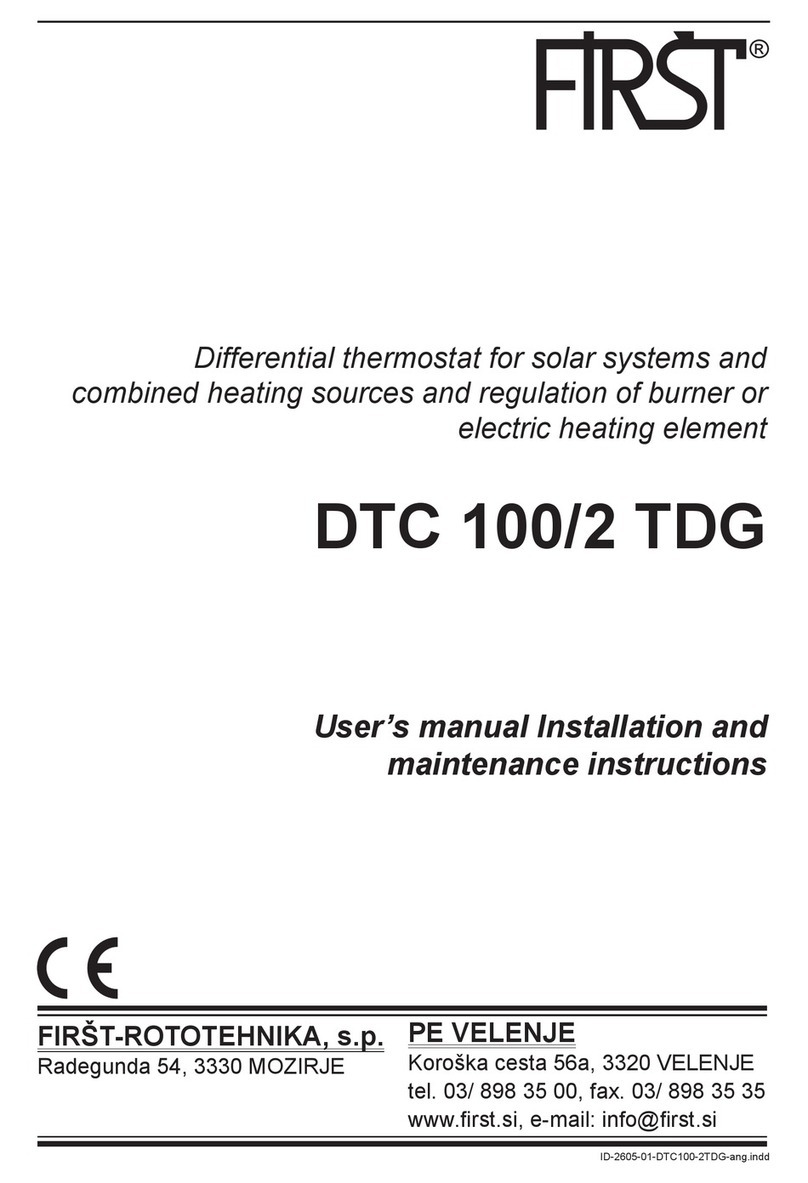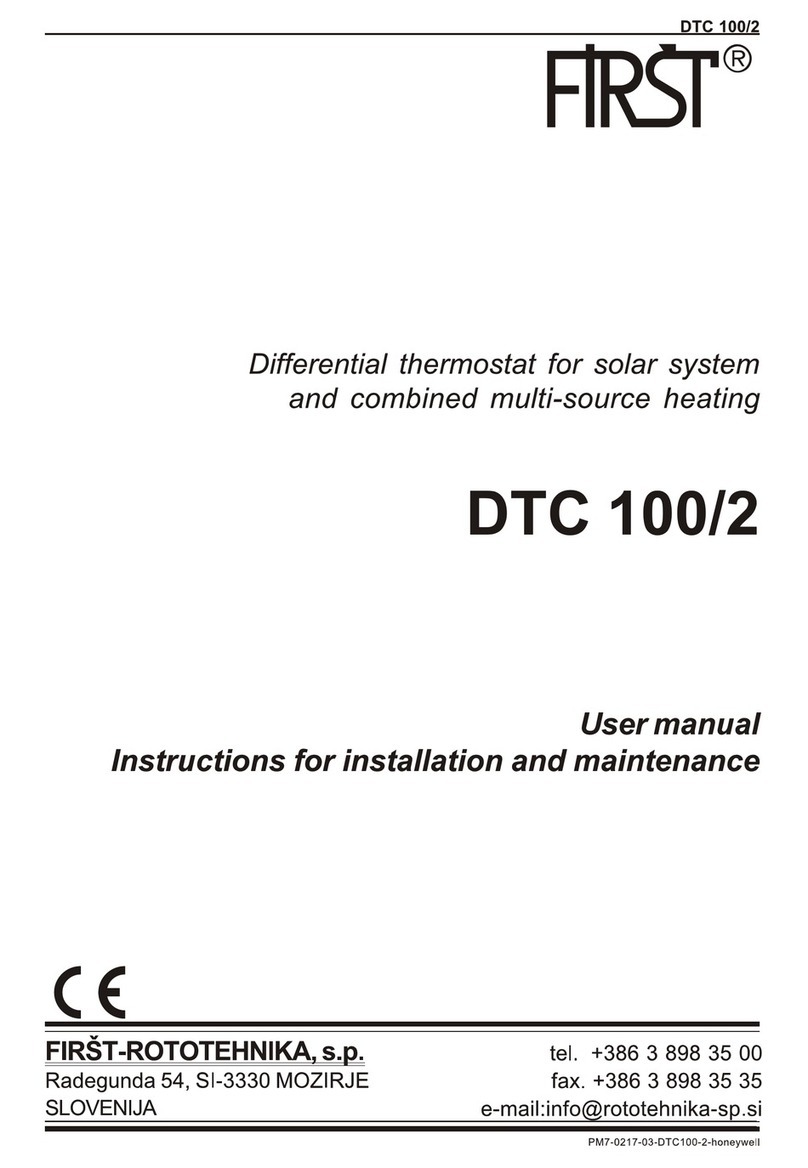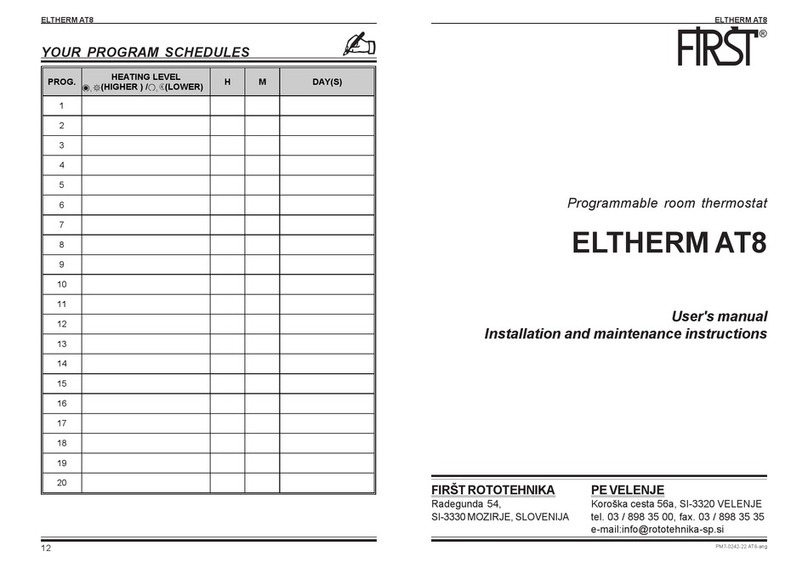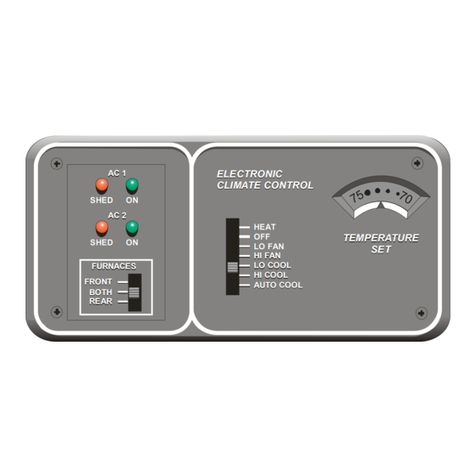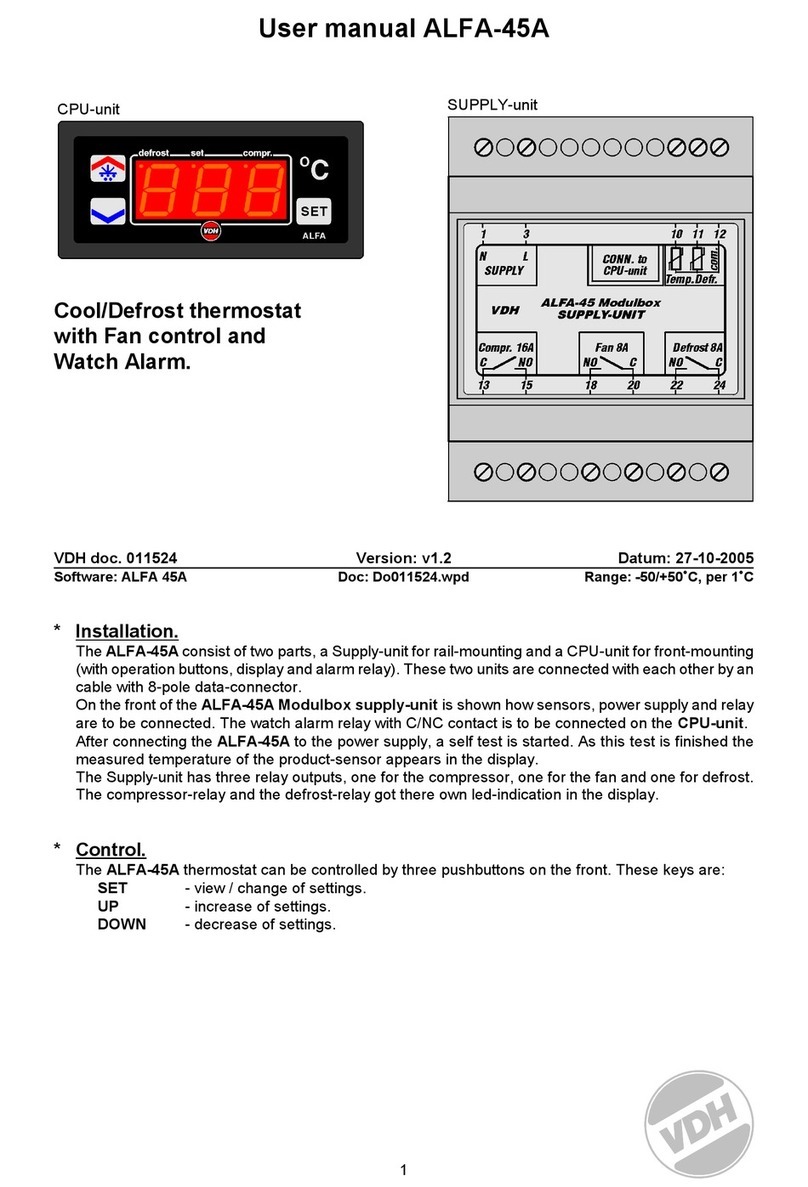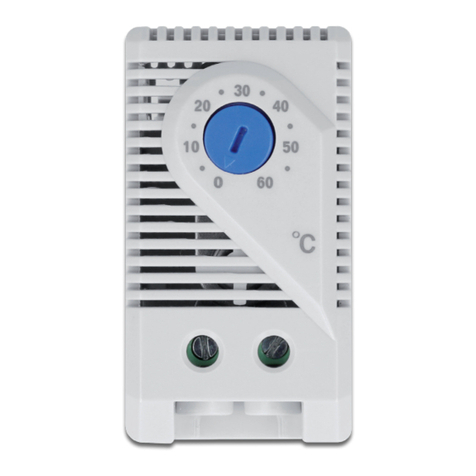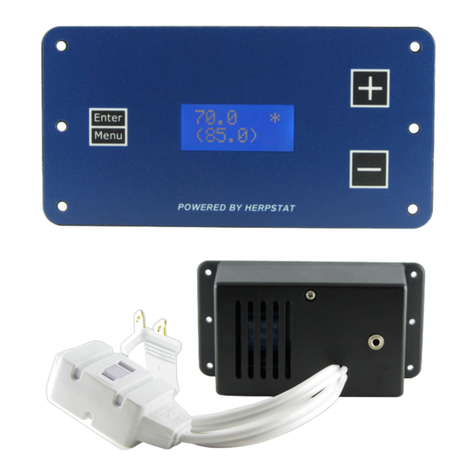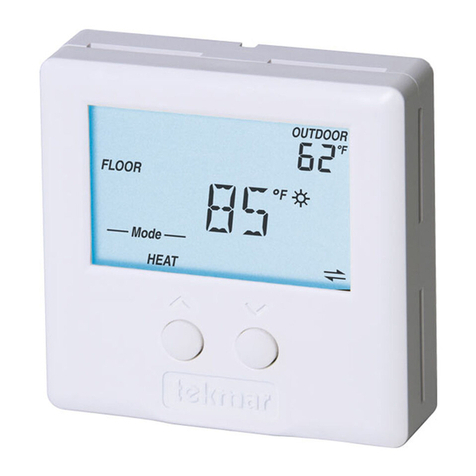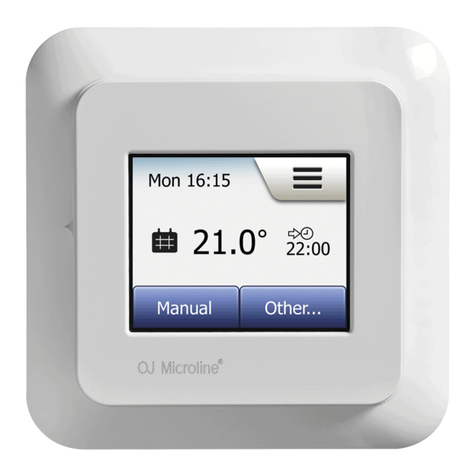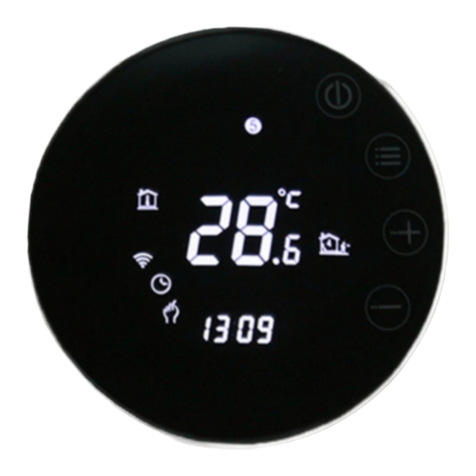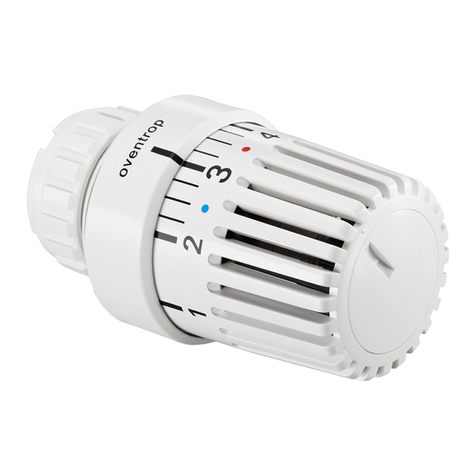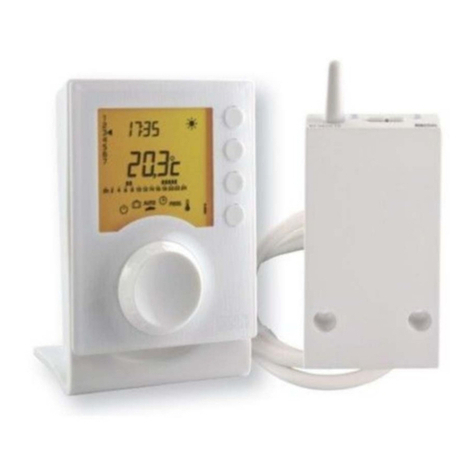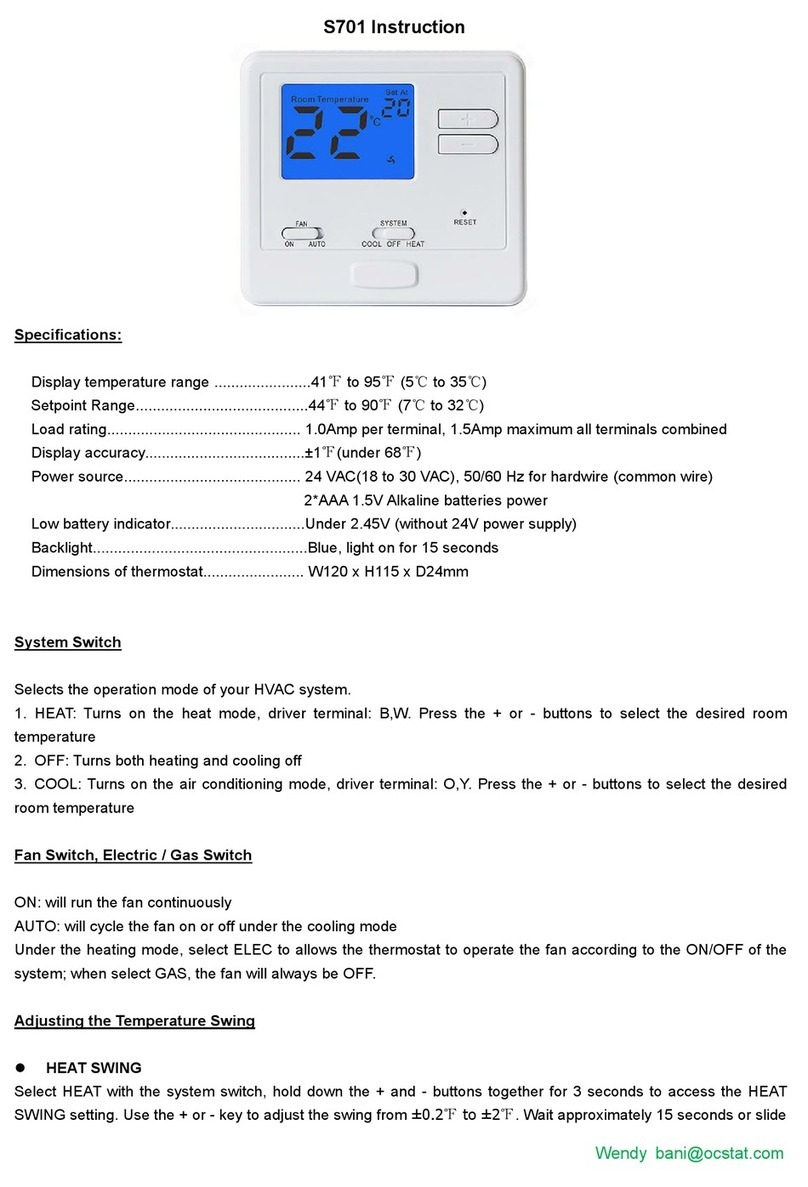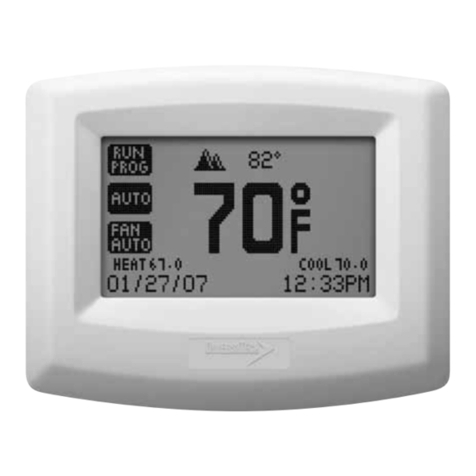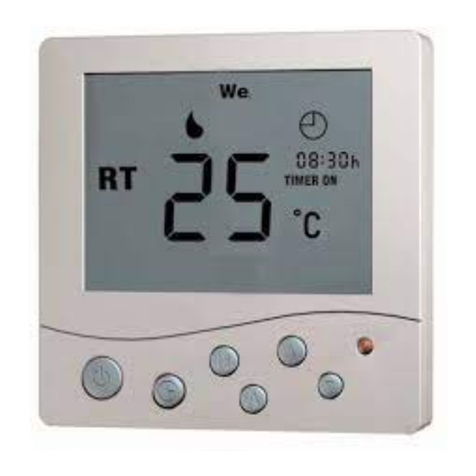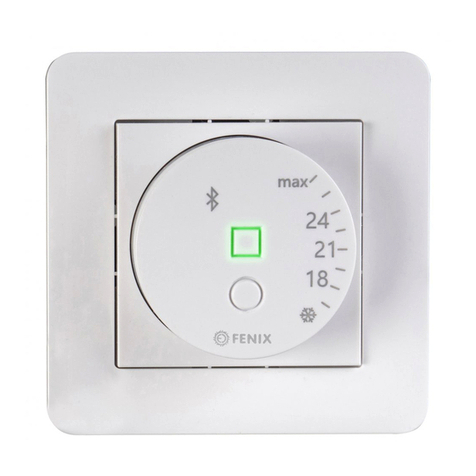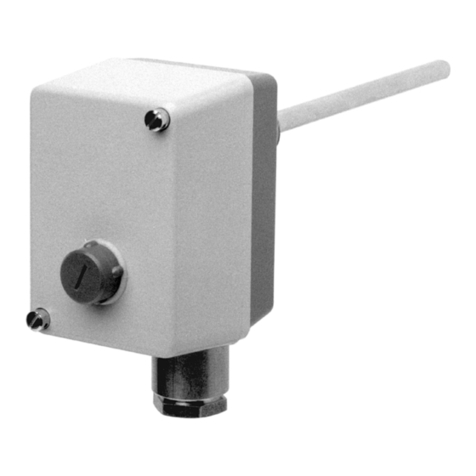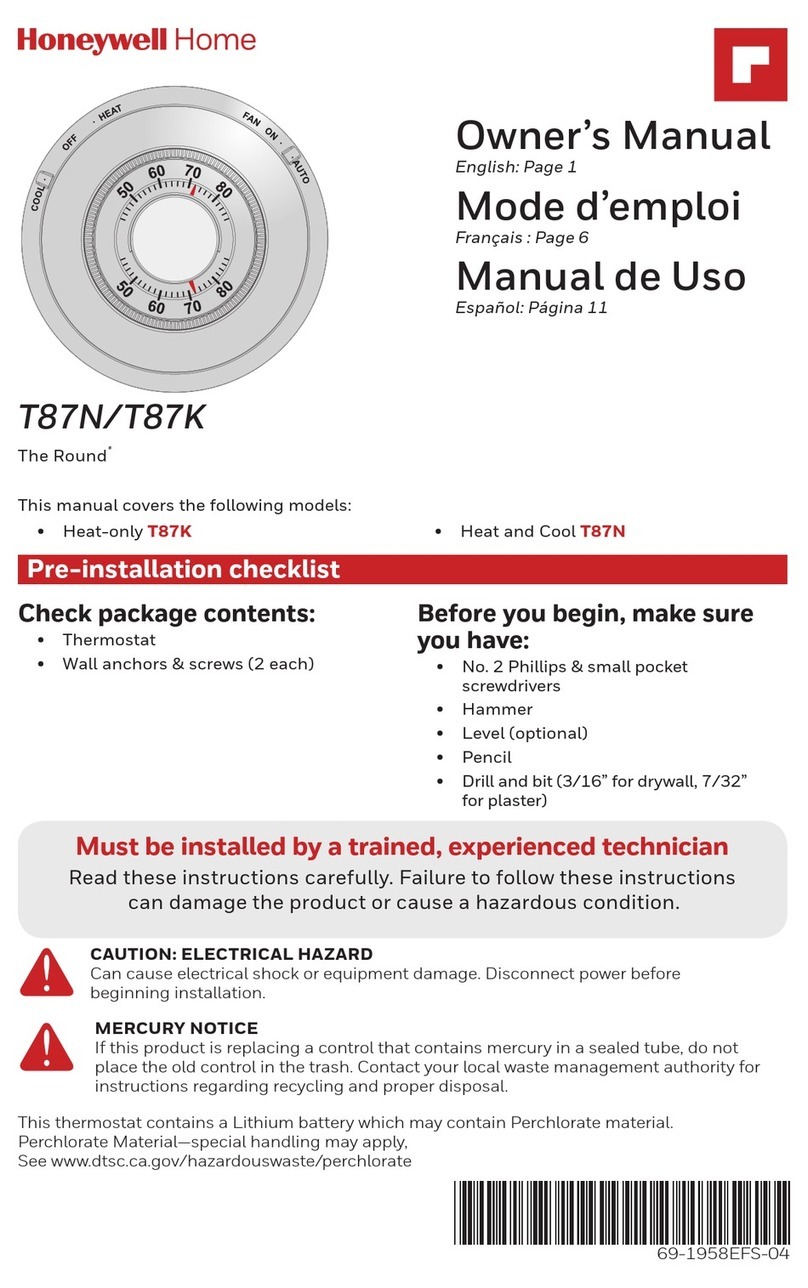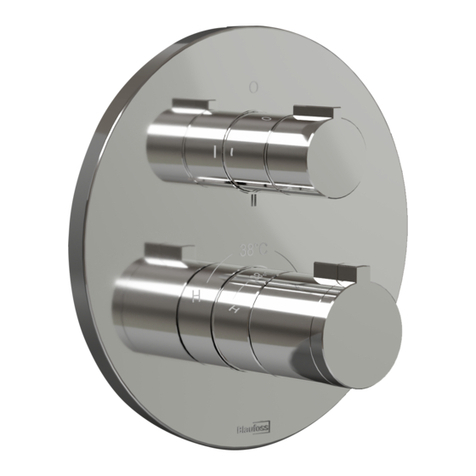First DTC 200/2G User manual

1
FIRŠT-ROTOTEHNIKA, s.p., Radegunda 54, SI-3330 Mozirje, Slovenija
tel. +386 3 898 35 00, fax. +386 3 898 35 35, e-mail: [email protected], http://www.rototehnika-sp.si
DTC 200/2G
Differential thermostat can be used for:
- Heating sanitary water with possibility to control
the burner.
- Cooling living space with blowing the cool
outside air into the living space
INSTALLATION INSTRUCTIONS
P7-3603-22-DTC200-2-montaža
WARNING!
Installation instructions are meant for specialist. All examples
listed in the instructions are merely indicative. The manufacturer
accepts no responsibility for incorrect hydraulic connection of
machine parts of installations should comply with all safety
regulations defined by law and the rules. Carefully read the
instructions to make good use of the product.
INFORMATION FOR ORDER: CODE
DTC 200/2G ..................................................................13017
The set consists of:
Differential thermostat DTC 200/2G, sensor BSF1, sensor KF,
mounting kit, installation instructions and instruction for use
Tube TV2 ...................................................................... 27080
(1/2", l=100mm, inner diameter 14mm)
INDEX:
Technical data ---------------------------------------------------------- 2
Testing sensors
Mounting the thermostat
Cables connection
Choosing the working regime -------------------------------------- 3
1. HEATING THE DOMESTIC HOT WATER FROM ONE HEATING
SOURCE (SOLAR COLLECTORS, BOILERS, HEAT PUMP...)
WITH CONTROLLING THE HEATING SOURCE (BURNER) --- 3
1.1 Basics
1.2 Operation
1.3 Sensors installation
1.4 Electrical connection --------------------------------------------- 4
1.5 Examples of use
2. HEATING THE DOMESTIC HOT WATER FROM ONE HEATING
SOURCE (SOLAR COLLECTORS, BOILERS, HEAT PUMP...)
WITH ADDITIONAL HEATING WITH ELECTRICAL HEATER -- 6
2.1 Basics
2.2 Operation
2.3 Sensors installation
2.4 Electrical connection
2.5 Examples of use --------------------------------------------------- 7
3. COOLING LIVING SPACE WITH BLOWING THE COOL
OUTSIDE AIR INTO THE LIVING SPACE -------------------------- 8
2.1 Basics
2.2 Operation
2.3 Sensors installation
2.4 Examples of use
2.5 Electrical connection
WITH DIFFERENTIAL THERMOSTAT ARE THREE
POSSIBLE WAY OF USE:
1. HEATING THE DOMESTIC HOT WATER FROM ONE HEATING
SOURCE (SOLAR COLLECTORS, BOILERS, HEAT PUMP...)
WITH CONTROLLING THE HEATING SOURCE (BURNER).
Differential thermostat controls the electric motor actuated ball
valve (EMV 110..) and the circulation pump. If it necessary turns
ON or OFF the heating source (burner).
2. HEATING THE DOMESTIC HOT WATER FROM ONE HEATING
SOURCE (SOLAR COLLECTORS, BOILERS, HEAT PUMP...)
WITH ADDITIONAL HEATING WITH ELECTRICAL HEATER.
Differential thermostat controls the electric motor actuated ball
valve (EMV 110..) and the circulation pump. In case that the
primary heating source (solar collectors, boilers...) has not
enough energy, water in water tank is heated with electrical
heater.
3. COOLING LIVING SPACE WITH BLOWING THE COOL
OUTSIDE AIR INTO THE LIVING SPACE
Differential thermostat controls the ventilator.
We reserve the right to modify the instructions and the technical
data of the product without prior notice.

FIRŠT-ROTOTEHNIKA, s.p., Radegunda 54, SI-3330 Mozirje, Slovenija
tel. +386 3 898 35 00, fax. +386 3 898 35 35, e-mail: [email protected], http://www.rototehnika-sp.si
2
DTC 200/2G
SENSORS TESTING:
For testing purposes of working of differential thermostat
sensors are simulated with resistors. Values of the resistors are
stated in the following table:
SENSOR DIMENSIONS: l
l=1,5m sensor BSF1, PVC, (gray cable) - DHWT sensor
l=2m sensor KF, silicon (red cable) - collector’s or
boiler’s sensor
Technical data: DTC 200/2G
Dimensions: 80x150x42 mm
Weight: 0,43 kg
Protection degree: IP 40/ DIN 40050
Heat class: B
Type of thermostat: P
Range of measuring temperature: -40°C ... +120°C
Setting working regime:
With jumpers (heating or cooling)
Limitation of temperature (depends of working regime):
Tmax: 5°C ... 85°C (heating regime)
Tmin: 5°C ... 85°C (cooling regime)
Temperature diference setting: 0K ... 15K
Hysteresis of thermostat: 1K-2K
Temperature of ambient: 0°C ... 40°C
Outputs: 2 relay outputs: 230V , 50Hz, 6(1)A,
working contact SPST :
- controlling the electric motor actuated ball valve and
pump
- burner
Inputs: 2 - sensors
- BSF1- PVC cable (1,5m long) - DHWT sensor
- KF - silicon cable (2m long) - collector’s or boiler’s sensor
Supply voltage: 230V , 50Hz
Power consumption: 4VA
Humidity: 5% - 70% (brez kondenza)
Storage temperature: 0°C-70°C
For housing is used material with resistance PTI=175>250
Mounting: on the wall
Recommendable cables:
sensors cables: J-Y (St) 1X 2X0,6
pump cables: H03VV-F 3x0,75
INSTALLATION OF THERMOSTAT
2.) Remove the thermostat’s cover.
Installation of housing bottom on the wall
1.) Unscrew the screw from bottom part of thermostat’s
housing.
With the printable template on the packaging drill two holes
(∅6mm) on the wall.
Put the enclosed two wall inserts into drilled holes (∅6mm)
and with two screws mount the housing bottom on the wall.
Do not mount the thermostat under water dropping.

3
FIRŠT-ROTOTEHNIKA, s.p., Radegunda 54, SI-3330 Mozirje, Slovenija
tel. +386 3 898 35 00, fax. +386 3 898 35 35, e-mail: [email protected], http://www.rototehnika-sp.si
DTC 200/2G
2. On-wall connection
a) Lead cables into the thermostat housing like as shown on
the picture. On one side lead the sensor cables and on the
other the rest. With two discharger screw the cables very tight to
prevent the extraction.
a)
b)
c)
CHOOSING WORKING REGIME
Before first use the working regime must be selected. It is set by
jumpers on the electronic circuit.
Differential thermostat can be used for:
- Heating sanitary water with possibility to control the burner.
- Cooling living space with blowing the cool outside air into the
living space
If it's used for heating, the
jumpers must be in position
"sun" (factory settings)
If it's used for cooling, the
jumpers must be in the
position "snowflake"
ELECTRICAL CONNECTION:
Non-isolated part of the conductor must be in the terminal
housing!
Before each interventions in the thermostat first
disconnect the main power!
d)
b) If it's not enough space for cables, use the knife and widen
the lead.
c) Cut the holes for cables lead on the housing cover
d) Use the knife and cut on spots 1 and 2 and brake remain.
ELECTRICAL CABLES CONNECTION
1. Flush mounted connection
Cables in the wall case lead through the holes in the bottom
of thermostat.

FIRŠT-ROTOTEHNIKA, s.p., Radegunda 54, SI-3330 Mozirje, Slovenija
tel. +386 3 898 35 00, fax. +386 3 898 35 35, e-mail: [email protected], http://www.rototehnika-sp.si
4
DTC 200/2G
T2 SENSOR’S INSTALLATION INTO DOMESTIC HOT WATER
TANK (DHWT):
Use BSF1 sensors with PVC cable insulation (GRAY
colour)!
Install T2 sensor to provided place in hot water tank or on hot water
tank wall under isolation as contact sensor in upper part of exchanger.
When sensor is mounted as contact one we recommend to coat it
with heat conducting paste or liquid metal.
In special purpose vertical or horizontal tube
(sensor should be protected against accidental
extraction).
On hot water tank with clip, wire and spring strip
(use paste for better heat transmission).
WARNING!
At mounting protect sensors against ambient influence and
assure suitabile mechanical protection.
Grounding wires should be
connected to special terminal
pins situated on left side of
terminal strips.
The thermostat is
designed for fixed
installation. When performing
electric installation, an element
should be inserted which
enables at least 3 mm
separation of thermostat from
the mains (switch or socket).
Prior to each intervention in the
thermostat, first disconnect it
from the mains.
ELECTRIC CONNECTION
Before each intervention in the thermostat first
disconnect the main power!
6(1)A, 250V
TERMINAL CONNECTION
1,2 sensorT1 - heating source (collector,boiler…)
3,4 sensor T2 - hot water tank
11 N - neutral - burner
12 L - phase - burner, 6(1)A, 250V , 50Hz
13 N - neutral pump
14 L - phase - pump 6(1)A, 250V , 50Hz
15 L - phase mains 230V , 50Hz
16 N - neutral mains 230V , 50Hz
BURNER control
11 12
DTC200/2G
Operating
thermostat Safety
thermostat
BOILER
230V
50 Hz
Main
switch
Switch
Choise (summer/winter regime)
1. HEATING THE DOMESTIC HOT
WATER FROM ONE HEATING
SOURCE (SOLAR COLLECTORS,
BOILERS, HEAT PUMP...) WITH
CONTROLLING THE HEATING
SOURCE (BURNER).
1.1 BASICS
Differential thermostat controls the electric motor actuated ball
valve (EMV 110..) and the circulation pump. If it necessary turns
ON or OFF the heating source (burner).
The thermostat enables setting of two parameters:
1. Regulation of maximum temperature in hot water tank from
5° to 85°C. This temperature is defined by T2 sensor witch is
generally mounted in upper third of heat exchanger.
2. Regulation of difference for exchanger from 0K to 15K.
With these regulation you define how much the value of the
source temperature (collector, boiler,...) should exceed the
temperature of water around the exchanger in hot water tank,
that the thermostat opens the valve and activates the pump.
The difference is set in relation to the volume of heat losses of
the system which depend on lengths of pipelines from source
to hot water tank and on pipeline insulation.
1.2 OPERATION
DTC 200/2G single differential thermostat measures the
temperature of heating source (collectors, boiler, ...) and in user
(hot water tank).
Heating effect is provided, when heating source temperature is
higher than the temperature of the user (water in hot water
tank). Consequently minimum difference should be 3K-5K.
Recommendable minimal value is 5K.
When the temperature of the source exceeds the temperature
around the user for pre-set difference opens the electric motor
actuated ball valve and switches the pump.
The thermostat switches off the pump if pre-set temperature is
reached in hot water tank (adjustable from 5° to 85°C).
If it's need for heating the hot water tank and the temperature of
heating source (boiler) is to low, then thermostat switch on the
burner of the boiler and when the conditions of the difference is
assured, pump is switch on.
The burner is always on, when the heating is needed.
1.3 SENSOR INSTALLATION
T1 SENSOR’S INSTALLATION INTO SOLAR COLLECTOR OR
BOILER:
Use KF sensors with silicon cable insulation (RED
colour)!
Install it as immersion sensor in collecting pipe at the top of the
collectors or boiler in provided sleeve. Sensor connect on the
terminals 1 and 2. Use the cable J-Y (St) 1X 2X0,6.
For cables longer than 15m we recommend over-voltage
protection with VDR resistor. For over voltage protection is
recommended use of armoured cable and it must be earthling.
flow direction
T-piece 1/2”
pipe1/2”
VDR resistor thermo-shrinkable
tubes
sensor cable
extension cable

5
FIRŠT-ROTOTEHNIKA, s.p., Radegunda 54, SI-3330 Mozirje, Slovenija
tel. +386 3 898 35 00, fax. +386 3 898 35 35, e-mail: [email protected], http://www.rototehnika-sp.si
DTC 200/2G
example: 3
Heating sanitary water with oil or gas burner.
Electric connection for example 3
7 (2W) - Electric motor actuated ball valve
EMV 110..series 602, 502
Jumper position
> HEATING <
1.5 EXAMPLES OF USE
example: 1
Heating sanitary water with solar collectors.
example: 2
Heating sanitary water with solid fuel boiler.
Electric connection for examples 1 and 2
Jumper position
> HEATING <
BURNER control
11 12
DTC200/2G
Operating
thermostat Safety
thermostat
BOILER
230V
50 Hz
Main
switch
Switch
Choise (summer/winter regime)

FIRŠT-ROTOTEHNIKA, s.p., Radegunda 54, SI-3330 Mozirje, Slovenija
tel. +386 3 898 35 00, fax. +386 3 898 35 35, e-mail: [email protected], http://www.rototehnika-sp.si
6
DTC 200/2G
SENSORS INSTALLATION IN HOT WATER TANK:
Install T2 sensor to provided place in hot water tank or on hot water
tank wall under isolation as contact sensor in upper part of exchanger.
When sensor is mounted as contact one we recommend to coat it
with heat conducting paste or liquid metal.
In special purpose vertical or horizontal tube
(sensor should be protected against accidental
extraction).
On hot water tank with clip, wire and spring strip
(use paste for better heat transmission).
WARNING!
At mounting protect sensors against atmosphere influence
and assure suitabile mechanical protection.
Grounding wires should be connected to special terminal
pins situated on left side of terminal strips.
The thermostat is designed for fixed installation. When
performing electric installation, an element should be
inserted which enables at least 3 mm separation of
thermostat from the mains (switch or socket). Prior to each
intervention in the thermostat, first disconnect it from the
mains.
ELECTRIC CONNECTION
Before each intervention in the thermostat first
disconnect the main power!
2. HEATING THE DOMESTIC HOT
WATER FROM ONE HEATING
SOURCE (SOLAR COLLECTORS,
BOILERS, HEAT PUMP...) WITH AD-
DITIONAL HEATING WITH ELECTRI-
CAL HEATER.
Differential thermostat controls the electric motor actuated ball
valve (EMV 110..) and the circulation pump. In case that the
primary heating source (solar collectors, boilers...) has not
enough energy, water in water tank is after-heated with electrical
heater.
2.1 BASICS
The thermostat enables setting two parameters:
1. Regulation of maximum temperature in hot water tank
from 5° to 85°C.
This temperature is defined by T2 sensor witch is generally
mounted in upper third of heat exchanger.
2. Regulation of difference for exchanger from 0K to 15K.
With these regulation you define how much the value of the
source temperature (collector, boiler,...) should exceed the
temperature of water around the exchanger in hot water tank,
that the thermostat opens the valve and activates the pump.
The difference is set in relation to the volume of heat losses of
the system which depend on lengths of pipelines from source
to hot water tank and on pipeline insulation.
2.2 OPERATION
DTC 200/2G single differential thermostat measures the
temperature of heating source (collectors, boiler, ...) and in user
(hot water tank).
Heating effect is provided, when heating source temperature is
higher than the temperature of the user (water in hot water
tank). Consequently minimum difference should be 3K-5K.
Recommendable minimal value is 5K.
When the temperature of the source exceeds the temperature
around the user for pre-set difference opens the electric motor
actuated ball valve and switches the pump.
The thermostat switches off the pump if pre-set temperature is
reached in hot water tank (adjustable from 5° to 85°C).
If it's need for heating the hot water tank and the temperature of
heating source (boiler) is to low, then thermostat switch on
electrical heater. Electrical heater after-heats water to desire
temperature.
Electrical heater is active, when the primary heating source is
inactive - they never work at same time. Priority has main heating
source (collector, boiler, ...).
2.3 SENSORS INSTALLATION
Install it as immersion sensor in collecting pipe at the top of the
collectors or boiler in provided sleeve. Connect sensor on the
terminals 1 and 2. Use the cable J-Y (St) 1X 2X0,6.
For cables longer than 15m we recommend over-voltage
protection with VDR resistor. For over voltage protection is
recommended use of armoured cable and it must be earthed.
flow direction
T-piece 1/2”
pipe1/2”
VDR resistor thermo-shrinkable
tubes
extension cable
sensor cable
TERMINAL CONNECTION
1,2 sensorT1 - heating source (collector,boiler…)
3,4 sensor T2 - hot water tank
11 N - neutral - el. heater
12 L - phase - el. heater, 6(1)A, 250V , 50Hz
13 N - neutral pump
14 L - phase - pump 6(1)A, 250V , 50Hz
15 L - phase mains 230V , 50Hz
16 N - neutral mains 230V , 50Hz
6(1)A, 250V

7
FIRŠT-ROTOTEHNIKA, s.p., Radegunda 54, SI-3330 Mozirje, Slovenija
tel. +386 3 898 35 00, fax. +386 3 898 35 35, e-mail: [email protected], http://www.rototehnika-sp.si
DTC 200/2G
2.5 EXAMPLES OF USE
example: 4
Heating water with solid fuel boiler. When there is not enough
energy, the water in storage tank is after-heated by el. heater.
Electric connection for example 4 and 5
example: 5
Heating sanitary water by central heating water. When energy
of central heating water is too low, the water in storage tank is
after-heated by el. heater.
Jumper position
> HEATING <
This action causes activity for only one heating source. They
never work at the same time. Priority has pump for solar heating.
If there is not enough solar energy, el. heater heats water.
WARNING:
In this way of use, the LED indicator does not show working
of el. heater.
It shows only need for heating sanitary water.
For this way of use, you have to cut jumper, which is shown on
lower picture.
7 (2W) - Electric motor actuated ball valve
EMV 110..series 602, 502

FIRŠT-ROTOTEHNIKA, s.p., Radegunda 54, SI-3330 Mozirje, Slovenija
tel. +386 3 898 35 00, fax. +386 3 898 35 35, e-mail: [email protected], http://www.rototehnika-sp.si
8
DTC 200/2G
3.4 EXAMPLES OF USE
example: 6
Cooling living space with blowing the cool outside air into the
living space
6(1)A, 250V
Jumper position
> COOLING <
Grounding wires should be connected to special terminal
pins situated on left side of terminal strips.
The thermostat is designed for fixed installation. When
performing electric installation, an element should be
inserted which enables at least 3 mm separation of
thermostat from the mains (switch or socket). Prior to each
intervention in the thermostat, first disconnect it from the
mains.
3. COOLING LIVING SPACE WITH
BLOWING THE COOL OUTSIDE AIR
INTO THE LIVING SPACE
Differential thermostat controls the ventilator.
3.1 BASICS
The thermostat enables setting two parameters:
1. Regulation of minimum temperature in living space 5° to
85°C.
This temperature is defined by T2 sensor witch is generally
mounted in reference position in the room.
2. Regulation of difference of outside and inside temperature
0K to 15K.
With this regulation you define how much the value of the source
temperature (outside air) should be lower than inside
temperature that thermostat switches on the ventilator.
3.2 OPERATION
DTC 200/2G single differential thermostat measures the
temperature of outside air and inside air.
Cooling effect is provided, when cooling source temperature is
lower than the temperature of inside air. Consequently
minimum difference should be 2K.
When the temperature of outside air is below the temperature
of inside air the ventilator switches on.
The thermostat switches off the ventilator if pre-set minimum
temperature is reached (adjustable from 5° to 85°C).
3.3 SENSORS INSTALLATION
Installation of outside sensor T1
Install it next to entrance of suction opening of the ventilator or
next to entrance of suction channel.
Installation of inside sensor T2
Install it on desired height, approximately on the centre in the
room space at least 0,5m from the ceiling. If not install correctly
the sensor will not detect real room temperature.
3.5 ELECTRIC CONNECTION
Before each interventions in the thermostat first
disconnect the main power!
TERMINAL CONNECTION
1,2 sensor T1 - cooling source (outside air)
3,4 sensor T2 - ambient
11 N - neutral - not in the function
12 L - phase - not in the function
13 N - neutral - ventilator
14 L - phase - ventilator 6(1)A, 250V , 50Hz
15 L - phase mains 230V , 50Hz
16 N - neutral mains 230V , 50Hz
Table of contents
Other First Thermostat manuals
